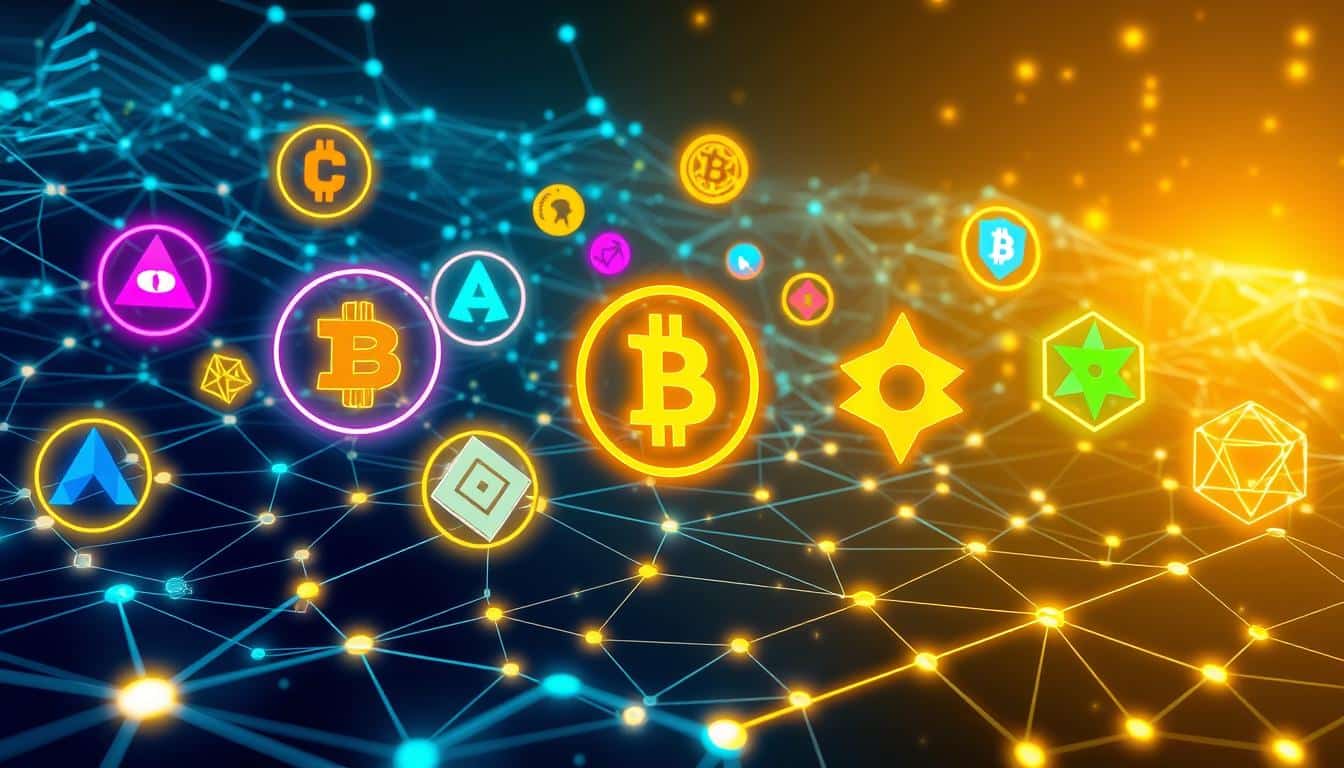Top Altcoins: Best Cryptocurrencies Beyond Bitcoin
Did you know altcoins make up over 40% of the crypto market cap1? This shows how much people are getting into cryptocurrencies that aren’t Bitcoin. Every year, thousands of altcoin projects start. They bring new chances for people who love cryptocurrency and blockchain technology. Ethereum has a huge market cap of $418.9 billion, and Binance Coin’s is also impressive at $89.8 billion2. So, the altcoin market is full of opportunities.
Key Takeaways
- Altcoins make up over 40% of the total cryptocurrency market capitalization, highlighting their growing significance1.
- Ethereum alone holds a market cap of approximately $418.9 billion2.
- Binance Coin (BNB) has a notable market valuation of $89.8 billion2.
- Altcoins provide diverse opportunities for investment beyond Bitcoin.
- The cryptocurrency market continues to expand with numerous altcoin projects launched each year1.
Exploring the top altcoins reveals unique features that motivate you to widen your crypto portfolio. They bring innovative blockchain technology applications and different market volatility levels to the table. There’s a lot to discover and think about here.
Introduction to Altcoins
Altcoins are key players in the vast world of cryptocurrencies. They broaden the ecosystem far beyond Bitcoin. They bring new features to the table, improving transaction speeds and lowering costs.
What are Altcoins?
Any cryptocurrency that isn’t Bitcoin is called an altcoin. Since 2011, they’ve been around. They serve many purposes, from payment systems to decentralized apps. Their benefits over old financial systems are clear. Ethereum, Tether, and USD Coin are good examples. Today, we have about 15,000 different cryptocurrencies, and altcoins make up a big chunk of the market345.
Why Consider Altcoins Another Option?
Investors and traders consider altcoins as another choice besides Bitcoin. They come with unique features and different uses in the DeFi world. While Bitcoin dominates 40% of the crypto market, altcoins bring chances for higher gains (and losses). DeFi’s growth has made some altcoins very popular. Many are listed on crypto exchanges, helping investors spread their risks. Despite low liquidity, the tech progress and decentralization in altcoins attract many34.
Ethereum was the first to offer a blockchain you can program on in 2015. Also, Peercoin introduced staking to the crypto world5.
In conclusion, altcoins offer exciting opportunities for those looking beyond Bitcoin. They drive the crypto industry towards more decentralization and efficiency. With their quick transactions and special tokens, altcoins play a big role in shaping the financial landscape.
Ethereum: The Leader in Smart Contracts
Ethereum is a front-runner in blockchain technology. It’s pushing the limits of smart contracts and decentralized apps (dApps). Known for its flexibility and strength, Ethereum is a vital part of the decentralized finance (DeFi) world.
Decentralized Applications (dApps) on Ethereum
Ethereum is crucial for hosting decentralized apps, or dApps. These apps operate on a peer-to-peer network, making operations transparent and secure. With smart contracts, developers can invent new services in finance and entertainment. This decentralized system boosts security and makes it easy to work with other blockchains.
Recent Developments and Updates
Ethereum is moving to proof-of-stake with its Ethereum 2.0 upgrade. This big step is aimed at improving scalability, security, and efficiency. Thanks to these updates, Ethereum remains a blockchain leader. It has a huge market cap of $281,009,253,0706 and supports projects and investors. Plus, it works well with over 55 other blockchains, showing its wide-reaching impact7.
Ethereum is set to grow with the XRPL EVM Sidechain in early 2025. This move, featuring Wrapped XRP (eXRP) as the gas token, highlights Ethereum’s adaptability. Ethereum keeps up with the changing blockchain world. It adds programmable features like Escrows, NFTs, and payment channels, broadening its DeFi presence7.
| Platform | Market Cap |
|---|---|
| Ethereum (ETH) | $281,009,253,0706 |
| Cardano (ADA) | $11,086,405,1716 |
| Tron (TRX) | $12,930,670,3686 |
| Internet Computer (ICP) | $3,265,951,7416 |
Binance Coin: More Than an Exchange Token
Binance Coin (BNB) has grown a lot since it started. It was first made to cut down trading fees on the Binance Exchange. Now, it’s a key part of the cryptocurrency world. BNB not only helps with lower fees but also supports Binance’s own blockchain, the Binance Chain.
Utilizing BNB on Binance Exchange
BNB is very useful on the Binance Exchange. If you have BNB, you get lower trading fees. This is great because Binance has more than 500 cryptocurrencies8. It also helps when you’re taking part in token sales on the Binance Launchpad. Plus, within the Binance Smart Chain ecosystem, it’s used to make and use dApps.
Growth and Market Impact of BNB
BNB has made a big splash in the market. As of July 2025, it’s worth about $242.55 each, reaching a market cap of $37.3 billion9. This success isn’t just because of Binance. It’s also valued highly on other exchanges. Its use across the Binance Smart Chain and other platforms shows its flexibility and growth potential.
In short, Binance Coin is way more than a simple token for exchanges. Its many uses boost its importance and value in the crypto scene. This makes it a key asset for anyone using the Binance platform and in the wider world of cryptocurrency.
Cardano: A Research-Based Approach
Cardano shines because it’s built on thorough research and uses reviewed methods. Charles Hoskinson launched it in 2017. It has a special two-layer design for better scalability and security10. Cardano aims to solve problems that Bitcoin and Ethereum face, like being able to handle more, work with different systems, and last longer11.
Ouroboros Proof-of-Stake Mechanism
Cardano’s heart is its Ouroboros proof-of-stake system. This system doesn’t use as much energy as Bitcoin and Ethereum do. Cardano’s network is way better for the environment, being 1.6 million times more efficient than Bitcoin12. It also processes more than 250 transactions a second. That’s much more than Bitcoin or Ethereum12.
Cardano’s Potential and Current Use Cases
Cardano’s DeFi space saw some pullback, with locked value dropping from $410 million to $350 million11. Yet, Cardano’s coin, $ADA, is still crucial, priced at $0.5111. The platform’s ongoing development highlights a strong push to innovate in blockchain11.
Cardano backs unique projects like Atala Prism in Ethiopia for managing identities without using the ADA token12. With its main wallets, Daedalus and Yoroi, you can stake assets and make decisions12. But, Cardano is still trying to reach Ethereum’s level, which has a vast number of apps and a larger DeFi presence10.
Here’s a comparative table showcasing Cardano and its primary competitor, Ethereum:
| Feature | Cardano | Ethereum |
|---|---|---|
| Year Founded | 2017 | 2015 |
| Consensus Mechanism | Ouroboros Proof-of-Stake | Proof-of-Work (transitioning to Proof-of-Stake) |
| Transaction Speed (TPS) | 250+ | 15-45 (Ethereum 1.0) |
| Energy Efficiency | 1.6 million times more efficient than Bitcoin | Relatively high (during Proof-of-Work phase) |
| Total Value Locked in DeFi | $350 million | Significant, leading the space |
| Smart Contract Language | Haskell | Solidity |
| Main dApps | Minswap, Sundaeswap | 3,600+ dApps |
By using a systematic and evidence-based method in its creation, and with the help of cutting-edge ideas like the Ouroboros mechanism, Cardano dreams of changing the game in blockchain and being a strong contender in the crypto world.
Solana: The Fast and Low-Cost Blockchain
Solana stands out as one of the fastest growing cryptocurrencies. It is known for its ultra-fast and cost-efficient transactions. With a value of $130.20, it can handle more than 50,000 transactions every second.
This makes it the fifth largest cryptocurrency by market cap13. It uses a special mix of proof-of-stake (PoS) and proof-of-history (PoH) in its system.
Solana’s Unique Hybrid Consensus Mechanism
Solana’s system is different from others because it uses both PoS and PoH. This mix helps it handle transactions quickly and securely. It’s a key reason why Solana’s blockchain is so fast while keeping costs low.
The use of PoH also makes Solana more efficient. This means it can run thousands of smart contracts and decentralized applications without a hitch.
Comparing Solana to Ethereum
Solana and Ethereum are quite different, especially in how they handle transactions. While Ethereum relies on proof-of-stake, it sometimes has high transaction fees. Solana, on the other hand, offers low fees and quick transactions.
This gives Solana an advantage, especially for those creating dApps or using them. It’s a potent alternative to Ethereum.
Some criticize Solana for being too centralized or having occasional system issues. Yet, it remains a major player in the DeFi and dApps world. Solana’s support for smart contracts and its speed make it a strong rival to Ethereum. It continues to push the boundaries of blockchain technology14.
How Ripple’s XRP Revolutionizes Transactions
XRP, created by Ripple, changes the game in cross-border payments. Thanks to the XRP Ledger’s tech, Ripple has made payments fast, reliable, and efficient. This transforms how we handle international money transfers.
The Technology Behind XRP Ledger
The XRP Ledger shines with its cutting-edge consensus protocol. It handles up to 1,500 transactions every second. That’s much more than Bitcoin’s 7-15. This capability is crucial for modern finance needs.
Unlike the usual systems, XRP’s method quickly validates transactions without mining. This cuts down energy costs a lot.
Usage in Banking and Cross-Border Payments
Over 200 banks globally are now working with Ripple. Many are looking into using XRP for quick, low-cost exchanges15. XRP excels as a bridge currency, making liquidity cheap and easy16.
Compared to Ethereum’s fluctuating fees, XRP only charges a tiny fixed fee per transaction. This makes it very affordable15.
Ripple’s technology has kept XRP competitive in the market. Sometimes, it even surpasses Bitcoin in value, reaching over 18,000 Satoshi15. Financial institutions find XRP a top choice for cost-effective and reliable transactions.
In short, Ripple’s XRP, with its unique tech, is revolutionizing how we do payments across borders. It offers speed, security, and savings. This makes it a strong alternative to usual bank systems and other digital currencies.
Exploring Tether and Stablecoins’ Role
Tether and other stablecoins offer a steadier option in the crypto world. They stick to currencies like the U.S. dollar. This helps Tether remain steady, drawing in investors who want to avoid big price swings. How they manage this, and the effects of picking stablecoins, are worth examining.
The Mechanism of Pegging to Fiat Currencies
Stablecoins, including Tether, are tied to regular money to keep their value constant. They hold cash reserves to back every Tether token17. This means each Tether has a real dollar saved which helps in the unpredictable crypto market. Such reserves are key to their promised steadiness.
Advantages and Disadvantages
Tether and similar stablecoins bring stability, ease of trading, and fit into the crypto world well. Being tied to the dollar, Tether doesn’t fluctuate much, making it useful for traders17. These coins also make moving between digital and regular money smoother, aiding in trades and money transfers.
Yet, stablecoins face criticisms. The truth about their dollar-backing claims, like Tether’s, has been questioned17. Also, having centralized bodies hold these reserves adds a risk not found in decentralized digital currencies.
Experts have thoroughly looked into how stablecoins, Bitcoin, and other digital coins interact. They note stablecoins like Tether meet the growing wish to invest in cryptos and help level out price swings18. Since 2017, the importance of stablecoins has jumped, underlining their increasing role. Rather than causing price bubbles, stablecoins mainly meet the rising investment demands, adding balance to the markets18.
The Rise of USD Coin
USD Coin (USDC) is becoming very popular as a digital currency. It offers a more stable and clear way to handle crypto money. The Centre Consortium created it. This group includes big names like Circle and Coinbase. USDC is a stablecoin, meaning it tries to keep its value equal to one U.S. dollar. This helps investors stay away from the big ups and downs other cryptocurrencies face.
USDC is special because it follows U.S. laws, making it a safe choice for investors. It’s known for being very open. Regular checks make sure every USDC is equal to one real dollar in the bank. This certainty attracts investors who don’t want surprises from market changes.
Looking at its market actions, USDC proves its worth. It has a big market cap of $34.8 billion19. It always has a stable price of $1.0020. While some cryptocurrencies like Solana shot up by 584%19, USDC’s zero percent return19 shows its stability.
In the vast world of cryptocurrencies, stablecoins like USDC are key for a balanced investment plan. USDC is especially trusted because of its rules. While others like Tether (USDT) and Binance Coin (BNB) have their charm, USDC is the best for those who want to keep their money’s value steady.
USDC has a strong spot in financial systems. It adds liquidity and strength next to other big stablecoins like Tether. Tether’s market cap is $118.1 billion with no change in returns19. USDC helps in keeping investments safe with less risk of loss.
| Cryptocurrency | Market Cap | Year-Over-Year Return |
|---|---|---|
| Bitcoin (BTC) | $1.2 trillion | 128% |
| Ethereum (ETH) | $301.4 billion | 53% |
| Tether (USDT) | $118.1 billion | 0% |
| USD Coin (USDC) | $34.8 billion | 0% |
| XRP (XRP) | $32.0 billion | 13% |
The unique selling propositions of USDC are its guaranteed stability and regulatory oversight, making it an indispensable asset for prudent investors navigating the volatile terrains of digital currency markets.
Dogecoin and Shiba Inu: The Meme Coins with Impact
Dogecoin and Shiba Inu stand out as iconic meme coins in the crypto world. Dogecoin began as a playful idea in 2013 but has since grown into a big name in cryptocurrency. It now has a market value of $14.42 billion and a price of $0.0985421. This shows how a strong community and social forces can drive a cryptocurrency’s success.
Shiba Inu, on the flip side, aims to challenge Dogecoin. It boasts a market cap of $7.97 billion and a value of $0.00013521. By July 2025, it’s expected to reach a market value of $9.83 billion22. Shiba Inu has burned 40% of its total supply, aiming to boost its value22.
In Shiba Inu’s world, Leash (LEASH) and Bone (BONE) are key players. LEASH’s supply is capped at 107,646, while BONE helps run the show with 250,000,000 tokens22. Unlike Dogecoin with its endless supply generating about 14,400,400 new DOGE daily, Shiba Inu aims to reduce its supply with each transaction22.
Dogecoin and Shiba Inu have brought exciting changes to the meme coin scene. Dogecoin’s quick block time of one minute is faster than Bitcoin, making transactions smoother22. Shiba Inu, meanwhile, is building a versatile DeFi ecosystem to grow its community even more22.
Experts believe Dogecoin might hit new highs by next year, potentially outdoing Bitcoin in the current cycle23. Similarly, Shiba Inu could surge to a new all-time high of $0.0001553 soon23.
The remarkable potential of meme coins like Dogecoin and Shiba Inu is often a hot topic among crypto fans. This underlines their growing impact on the industry.
| Meme Coin | Market Cap (USD) | Price (USD) |
|---|---|---|
| Dogecoin (DOGE) | $14.42 billion | $0.09854 |
| Shiba Inu (SHIB) | $7.97 billion | $0.000135 |
| Pepe (PEPE) | $3.16 billion | $0.000007494 |
| Dogwifhat (WIF) | $1.48 billion | $1.48 |
| Bonk (BONK) | $1.19 billion | $0.00001709 |
| Floki (FLOKI) | $1.17 billion | $0.0001223 |
| Brett (BRETT) | $747.13 million | $0.07486 |
| Dogs (DOGS) | $627.97 million | $0.001206 |
| Popcat (POPCAT) | $565.59 million | $0.566 |
| Book of Meme (BOME) | $412.09 million | $0.005952 |
Toncoin: From Messaging to Blockchain
Toncoin first started within the Telegram Open Network. It was meant to help with payments inside Telegram’s app. But soon, it turned into The Open Network. This change made it a blockchain powerhouse guided by the community.
Toncoin’s growth has been outstanding. Its Total Value Locked (TVL) jumped from $14 million in September 2025 to $386 million by July 202524. Daily transactions climbed from 1 million to over 5 million, showing active engagement24. And it has over 1.2 million active addresses, proving it’s used far and wide24.
The financial results are impressive too. Toncoin’s annual returns hit about 74% in the last three years24. Its highest gain was 470%, with a current rate of 330%, beating Bitcoin24. Plus, a Sharpe ratio of 0.99 shows its returns are solid, even when compared to established markets like Nifty 5024.
Now, Toncoin’s market cap is $22.5 billion, with a Full Diluted Valuation (FDV) at $33.2 billion. It also has a circulating supply of 3.47 billion (68%)25. The number of active monthly wallets skyrocketed from 200,000 to nearly 1.7 million25. And it has a total value locked of $140 million25, showing significant adoption.
TON’s infrastructure is upheld by prominent decentralized exchanges (DEXs) on TON Chain. The top DEX, $STON, has $80 million locked in value. The second, DeDust, holds $49 million25. These stats highlight the growing network and successful blockchain technology use.
Wrapping up, Toncoin has moved beyond a simple messaging tool. It’s now a full blockchain solution. Its fast processing time and proof-of-stake tech place it high in the crypto world. With solid annual returns, a good Sharpe ratio, and more users, Toncoin is redefining blockchain’s power.
Avalanche: Ethereum’s Emerging Competitor
Avalanche is stepping up as a strong rival to Ethereum with its advanced blockchain tech. It’s a layer-one blockchain that uses a special design. This design includes three interlinked blockchains. These blockchains tackle the big three challenges: scalability, security, and decentralization.
Three Interoperable Blockchains
Avalanche’s power comes from its clever design of three connected blockchains. These are the X-Chain, C-Chain, and P-Chain. They each have a unique role. Together, they boost performance and keep the system decentralized. The X-Chain lets users create and trade assets. The C-Chain handles smart contracts. And the P-Chain manages validators, ensuring the network can handle lots of transactions without sacrificing security.
Avalanche’s Approach to Scalability
Avalanche stands out by how it handles lots of transactions quickly. Its consensus protocol is the key to its faster processing times. This makes it great for DeFi projects. Thanks to its three linked blockchains, Avalanche can scale up efficiently. This makes it both fast and secure, perfect for today’s blockchain needs26.
Tron: The DAO with Growing Influence
Tron has grown from its start in Singapore into a key player in the crypto world. By the first quarter of 2025, its market value shot up by 15%, hitting a huge $10.5 billion. This shows its quick growth in the cryptocurrency scene27.
In the same timeframe, Tron made over $128.1 million, proving its ecosystem’s strength and presence in the market27. Its price also went up by 2.7% in a day. Over the week, it increased by 8%, showing that investors believe in its future and its ongoing growth27.
Even with the crypto market’s ups and downs, Tron only had a small 3% drop in the last 30 days. This shows it can stand strong27. The plan to start gasless transactions later this year should make it even more popular. It illustrates Tron’s dedication to bringing new things to the table28.
Justin Sun, the creator of Tron, has big plans for the rest of the year. He wants to get more users, make their experiences better, and keep the blockchain’s key strengths28. The number of active users has stayed really high. This is thanks to Tron’s different uses in payments, stablecoins, and real-world things28. Its focus on being useful makes Tron stand out from other cryptocurrencies.
For tips on good altcoin investments like Tron, check out this detailed guide27.
Polkadot: Powering a New Era of Blockchain Integration
Polkadot is bringing about a huge change in blockchain networks integration. It’s building an ecosystem where separate blockchains can work together easily. This makes it possible for blockchain technology to connect with each other smoothly. It’s a big step for the future of decentralized apps, giving them stronger and wider infrastructure to run on.
The idea of Polkadot came from Dr. Gavin Wood, an Ethereum co-founder, back in 2016. It represents a fresh approach to blockchain technology. By 2020, it shifted to a proof-of-stake model. This means DOT token holders now play a big part in its governance. It shows Polkadot’s dedication to being open and run by its community, which is key for blockchain’s progress.
The Polkadot Relay Chain stands at the core of this network. It’s set to support around 100 parachains. This will hugely improve how many transactions it can handle29. Once fully set up, Polkadot could deal with 1 million transactions every second. This fast processing is crucial for decentralized application growth29.
One key event showing off Polkadot’s growth is Polkadot Decoded, happening in Brussels on July 11th and 12th, 2025. It will gather over 100 speakers and more than 100 companies and projects. They’ll look into what’s coming next for Web330. Over 1,500 people are expected to come, making it a hub for learning and sharing ideas on five different stages30.
Polkadot’s design lets blockchains focus on what they do best. This means developers can build solutions that really fit their needs. Each parachain is made to handle specific tasks. This adds to the strength and flexibility of the Polkadot network.
Looking at it as an investment, Polkadot (DOT) is both promising and risky, just like the broader crypto market. Even with a small drop in price recently, its long-term outlook looks strong. Investors should focus on long-term goals in the diverse world of crypto31. It’s important to stay committed to a long-term plan and see the big picture in Web3’s growth.
| Event | Date | Details |
|---|---|---|
| Polkadot Decoded | July 11-12, 2025 | Featuring over 100 speakers and 100+ companies & projects30 |
| Keynote by Dr. Gavin Wood | July 11, 2025 | Scheduled at 11:40 AM local time in Brussels30 |
| Parachain Rollout | 2020 | Started with the Rococo testnet for testing multi-chain network concepts29 |
With the title of the world’s largest Decentralized Autonomous Organization (DAO), Polkadot’s role in shaping blockchain is huge30. Delving into Polkadot means exploring its power to change the blockchain world and aid decentralized apps.
XRP: Fast and Efficient Transactions
XRP’s payment processing speed is a game-changer in digital tech. It’s designed to speed up transactions, with the XRP Ledger completing settlements in just 3-5 seconds. That’s much faster than Bitcoin and Ethereum32. This swift processing greatly boosts user experience and financial operations.
The network can handle thousands of transactions every second. This puts it ahead in the blockchain tech race. Even EOS, with a peak speed of 4,000 TPS, can’t outdo XRP’s scalability and usability32. The XRP Ledger’s smart design leads to low fees, making transfers cheap regardless of amount32.
XRP stands out by tackling digital tech’s big issues. Factors like network load and transaction complexity impact speed. XRP optimizes these, making blockchain tech more accessible and useful32. This is key for quick payment needs like in finance and supply chains32.
XRP started with 100 billion tokens, with 80 billion going to Ripple for liquidity33. This liquidity, combined with its anti-censorship and anti-counterfeit features, makes XRP a strong altcoin player. It has a big potential for growth in the digital tech field33.
Ripple’s XRP is changing the payment processing world. It offers fast transactions, low costs, and strong technology. It’s a valuable player in the digital market. As the industry grows, XRP’s role in making financial transactions faster and more efficient will only get bigger.
Top Altcoins: Investment Strategies for Your Crypto Portfolio
Investing in top altcoins is about having a smart plan. You need to know market trends, manage risks well, and spread out your crypto investments. This will really help your portfolio do better.
Understanding Market Trends
Keeping up with market trends is key in the unpredictable crypto market. Bitcoin often makes up more than half of the total crypto market value34. Ethereum is also a major player, with a market cap of $247 billion34. Altcoins like Solana can skyrocket, as seen by a nearly 1000% increase from December 2022 to March 202534.
Risk Management Techniques
Good risk management is vital for your crypto investment plan. Bitcoin and Ethereum are stable but offer lower rewards. Mid-cap and low-cap cryptos can give you bigger wins but are riskier35. Putting 80% of your money in big cryptos and 20% in smaller ones can work well35. Or, try a 40/30/30 mix with some in the top 2 cryptos, some in large caps, and the rest in mid to small caps35.
Diversifying Your Crypto Investments
Spreading your investments in various cryptos can reduce risks and boost profits. The 80/20 rule and the 40/30/30 plan are great for this35. Adding stablecoins, like USDC, keeps your investment stable since USDC always equals one dollar34. To diversify, think about including Bitcoin, Ethereum, Cardano, Chainlink, Binance Coin, and Avalanche in your mix35.
Conclusion
The crypto investment scene is more than just Bitcoin. It includes many altcoins that bring exciting opportunities for those looking to diversify. Ethereum leads in smart contracts and shapes the DeFi world with a huge ecosystem. Its market cap is impressive at $370,862,895,10636. Binance Coin is key within Binance’s various services. It has a strong market cap of $76,051,048,89036. Solana also stands out with its fast transactions and mixed consensus method, making it the 5th biggest cryptocurrency37.
Altcoins like Ripple’s XRP and Cardano add variety to the market. Ripple changes how cross-border payments work with its vast amount of circulating XRP. Cardano is all about research and blockchain’s future, focusing on scalability and uses across many industries.
To sum up, altcoins bring exciting choices for your crypto portfolio. From Ethereum’s apps to Solana’s quick processing, these coins are vital in blockchain tech. Staying updated with market trends and using each altcoin’s unique strengths can lead to a successful investment strategy.







 Bitcoin
Bitcoin  Ethereum
Ethereum  Tether
Tether  XRP
XRP  USDC
USDC  TRON
TRON  Lido Staked Ether
Lido Staked Ether  Dogecoin
Dogecoin  Figure Heloc
Figure Heloc  Cardano
Cardano  WhiteBIT Coin
WhiteBIT Coin  Bitcoin Cash
Bitcoin Cash  Wrapped stETH
Wrapped stETH  Wrapped Bitcoin
Wrapped Bitcoin  USDS
USDS  Wrapped eETH
Wrapped eETH  Binance Bridged USDT (BNB Smart Chain)
Binance Bridged USDT (BNB Smart Chain)  Chainlink
Chainlink  LEO Token
LEO Token  Zcash
Zcash  Monero
Monero  WETH
WETH  Coinbase Wrapped BTC
Coinbase Wrapped BTC  Stellar
Stellar  Ethena USDe
Ethena USDe  Hyperliquid
Hyperliquid  Litecoin
Litecoin  Canton
Canton  Avalanche
Avalanche  Sui
Sui  Hedera
Hedera  USDT0
USDT0  Dai
Dai  sUSDS
sUSDS  Shiba Inu
Shiba Inu  Toncoin
Toncoin  World Liberty Financial
World Liberty Financial  PayPal USD
PayPal USD  Uniswap
Uniswap  Cronos
Cronos  Ethena Staked USDe
Ethena Staked USDe  USD1
USD1  Mantle
Mantle  Polkadot
Polkadot  Rain
Rain  MemeCore
MemeCore  Bitget Token
Bitget Token  OKB
OKB